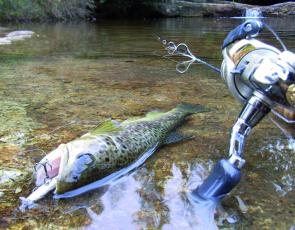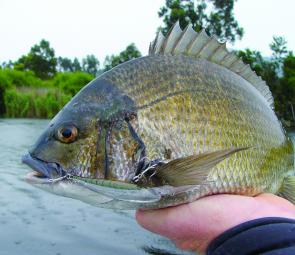January’s highlight is the substantial numbers of southern calamari that can be found throughout the lower Derwent region.
This month should see a peak in numbers of both species of squid. The larger arrow squid are quite aggressive and can be readily caught on prawn style jigs. A slow lift and drop retrieve with a 3 or 4” jig will do.
Other common methods are to suspend your squid jig under a float or even try drifting with a couple of jigs trailing behind the boat on set rods. The drift method works well on light breeze days and can be done while you probe the bottom for flathead with baits or soft plastics.
Cocky and black-back salmon schools continue to pop up where ever a good showing of bait occurs. These fish are in a feeding mood at the moment as they race to put on condition while the bait congregations are thick. Trolling with metal slice lures, bibbed minnows or even a white streamer fly are all good ways to locate a school. Once the salmon are found it can be worth applying a little burley to keep the fish around.
Better-sized black-backs have been more common outside the main river around the Primrose Sands and South Arm areas. The Carlton River mouth has also continued to attract bait and hence the salmon, particularly in the late afternoon.
Warmer water temperatures have encouraged the local flatties to bite with more consistency over the last month or so. While fresh cut baits are adequate and still a very popular way to entice flathead onto your hook while bottom bouncing. It seems more and more saltwater anglers are trading in their handlines and broomstick like boat rods for light saltwater spin gear loaded with braided line. These outfits are great for soft plastic bouncing for flathead and also cast well if salmon or couta show up. Going light also brings a bit of fun back into acquiring a feed of flatties.
The distribution of fish has continued to be influenced by the late spawn movements. By the end of this month most of the bream will have found their way back into the mid reaches of the Derwent. The area between the Bridgewater and Tasman bridges is considered to be the mid section of the river.
The post spawn period is considered by many to be the highlight of the bream season. The fish are no longer taxed by spawning requirements and seem to return to a more natural or instinctual feeding habits.
Initially, bream will be found at prominent structures such as Cadbury Point and the Bowen Bridge. The fish will then break up into smaller pods and tend to prefer to hunt out mussels, crabs and baitfish in the shallows.
Any areas that exhibit undulating rocky flats or reefs seem to really come alive through mid summer and into the autumn months. Just about any point or bay in the Derwent will have some suitable areas for shallow feeding bream. A good way to find the most likely holding points on these flats is to inspect the shores at the bottom of the tide. Often you will be able to find a ledge, stump or grouping of small boulders that the local bream use as an ambush point during the top of the tide.
Good amounts of small bream in the 10-25cm range have been increasingly apparent during December. A few seasons ago there seemed to be little or no juvenile bream in the Derwent.
Upsizing hardbodied lures and fishing deeper or a little wider from the shore can help to avoid the mini-bream.
January is one of the best times of the year to try hardbodied lures for bream. If you haven’t had much success with this style of presentation before, now is the right time to have another go.
Make sure you use a light braided line such as a 4lb gelspun, 6 or 8lb PE or even have a go with a 3 or 4lb spool of fluorocarbon monofilament line. Use a long and light 3 or 4lb fluorocarbon leader in conjunction with a loop knot at the lure when using braid to throw hard lures.
Recently I’ve been messing about with fly patterns for bream and have found a small weighted Clouser or Crazy Charlie in white or chartreuse to be a good fly. I’ve been using a 7/8-weight rod and a 3m leader of stiff 5kg fluorocarbon on a sinking line. To my surprise the bream have been very eager to take, particularly on the pause after a few short strips. Give it a go as the bream go hard on the fly rod.
Most trout anglers have their trout radar firmly focused on the great river fishing that’s happening now. Local streams such as the Styx, Tyenna and Russel rivers are all fantastic waters over the warmer months. Small hard lures such as an Ecogear MX 48f or Strike Pro Smeltas are dynamite when worked along current seams in these small waters.
Fly anglers will do well with both small dries and fat hopper patterns alike. The hoppers should be a strong presence this season with all the lush growth about. Fishing hopper patterns is a real event for many local fly enthusiasts as the takes are memorable when trout slash at the fly, eager to get hold of one of their favourite morsels.
A splat style presentation often helps to ring the dinner bell for trout on the lookout for these largish insects. Casting to sighted trout and swinging the fly against cover are both good ways to secure a strike.
Reads: 5009
Small stream fishing with hardbodies lures is a great option for January.

The Derwent is the bream capital of the Universe in summer with plenty of fat fish on the shallow shores.

Fat cocky and black-back salmon abound through the system at present feeding on large bait schools.

Large jerkbait style hardbodies are a good option when the bream sit deeper during the day.




